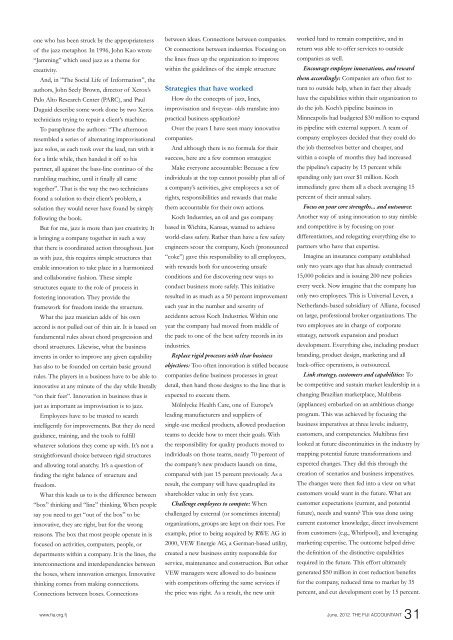Download - Fiji Institute of Accountants
Download - Fiji Institute of Accountants
Download - Fiji Institute of Accountants
You also want an ePaper? Increase the reach of your titles
YUMPU automatically turns print PDFs into web optimized ePapers that Google loves.
one who has been struck by the appropriateness<br />
<strong>of</strong> the jazz metaphor. In 1996, John Kao wrote<br />
“Jamming” which used jazz as a theme for<br />
creativity.<br />
And, in ”The Social Life <strong>of</strong> Information”, the<br />
authors, John Seely Brown, director <strong>of</strong> Xerox’s<br />
Palo Alto Research Center (PARC), and Paul<br />
Duguid describe some work done by two Xerox<br />
technicians trying to repair a client’s machine.<br />
To paraphrase the authors: “The afternoon<br />
resembled a series <strong>of</strong> alternating improvisational<br />
jazz solos, as each took over the lead, ran with it<br />
for a little while, then handed it <strong>of</strong>f to his<br />
partner, all against the bass-line continuo <strong>of</strong> the<br />
rumbling machine, until it finally all came<br />
together”. That is the way the two technicians<br />
found a solution to their client’s problem, a<br />
solution they would never have found by simply<br />
following the book.<br />
But for me, jazz is more than just creativity. It<br />
is bringing a company together in such a way<br />
that there is coordinated action throughout. Just<br />
as with jazz, this requires simple structures that<br />
enable innovation to take place in a harmonized<br />
and collaborative fashion. These simple<br />
structures equate to the role <strong>of</strong> process in<br />
fostering innovation. They provide the<br />
framework for freedom inside the structure.<br />
What the jazz musician adds <strong>of</strong> his own<br />
accord is not pulled out <strong>of</strong> thin air. It is based on<br />
fundamental rules about chord progression and<br />
chord structures. Likewise, what the business<br />
invents in order to improve any given capability<br />
has also to be founded on certain basic ground<br />
rules. The players in a business have to be able to<br />
innovative at any minute <strong>of</strong> the day while literally<br />
“on their feet”. Innovation in business thus is<br />
just as important as improvisation is to jazz.<br />
Employees have to be trusted to search<br />
intelligently for improvements. But they do need<br />
guidance, training, and the tools to fulfill<br />
whatever solutions they come up with. It’s not a<br />
straightforward choice between rigid structures<br />
and allowing total anarchy. It’s a question <strong>of</strong><br />
finding the right balance <strong>of</strong> structure and<br />
freedom.<br />
What this leads us to is the difference between<br />
“box” thinking and “line” thinking. When people<br />
say you need to get “out <strong>of</strong> the box” to be<br />
innovative, they are right, but for the wrong<br />
reasons. The box that most people operate in is<br />
focused on activities, computers, people, or<br />
departments within a company. It is the lines, the<br />
interconnections and interdependencies between<br />
the boxes, where innovation emerges. Innovative<br />
thinking comes from making connections.<br />
Connections between boxes. Connections<br />
between ideas. Connections between companies.<br />
Or connections between industries. Focusing on<br />
the lines frees up the organization to improve<br />
within the guidelines <strong>of</strong> the simple structure<br />
Strategies that have worked<br />
How do the concepts <strong>of</strong> jazz, lines,<br />
improvisation and fiveyear- olds translate into<br />
practical business application?<br />
Over the years I have seen many innovative<br />
companies.<br />
And although there is no formula for their<br />
success, here are a few common strategies:<br />
Make everyone accountable: Because a few<br />
individuals at the top cannot possibly plan all <strong>of</strong><br />
a company’s activities, give employees a set <strong>of</strong><br />
rights, responsibilities and rewards that make<br />
them accountable for their own actions.<br />
Koch Industries, an oil and gas company<br />
based in Wichita, Kansas, wanted to achieve<br />
world-class safety. Rather than have a few safety<br />
engineers scour the company, Koch (pronounced<br />
“coke”) gave this responsibility to all employees,<br />
with rewards both for uncovering unsafe<br />
conditions and for discovering new ways to<br />
conduct business more safely. This initiative<br />
resulted in as much as a 50 percent improvement<br />
each year in the number and severity <strong>of</strong><br />
accidents across Koch Industries. Within one<br />
year the company had moved from middle <strong>of</strong><br />
the pack to one <strong>of</strong> the best safety records in its<br />
industries.<br />
Replace rigid processes with clear business<br />
objectives: Too <strong>of</strong>ten innovation is stifled because<br />
companies define business processes in great<br />
detail, then hand those designs to the line that is<br />
expected to execute them.<br />
Mölnlycke Health Care, one <strong>of</strong> Europe’s<br />
leading manufacturers and suppliers <strong>of</strong><br />
single-use medical products, allowed production<br />
teams to decide how to meet their goals. With<br />
the responsibility for quality products moved to<br />
individuals on those teams, nearly 70 percent <strong>of</strong><br />
the company’s new products launch on time,<br />
compared with just 15 percent previously. As a<br />
result, the company will have quadrupled its<br />
shareholder value in only five years.<br />
Challenge employees to compete: When<br />
challenged by external (or sometimes internal)<br />
organizations, groups are kept on their toes. For<br />
example, prior to being acquired by RWE AG in<br />
2000, VEW Energie AG, a German-based utility,<br />
created a new business entity responsible for<br />
service, maintenance and construction. But other<br />
VEW managers were allowed to do business<br />
with competitors <strong>of</strong>fering the same services if<br />
the price was right. As a result, the new unit<br />
worked hard to remain competitive, and in<br />
return was able to <strong>of</strong>fer services to outside<br />
companies as well.<br />
Encourage employee innovations, and reward<br />
them accordingly: Companies are <strong>of</strong>ten fast to<br />
turn to outside help, when in fact they already<br />
have the capabilities within their organization to<br />
do the job. Koch’s pipeline business in<br />
Minneapolis had budgeted $30 million to expand<br />
its pipeline with external support. A team <strong>of</strong><br />
company employees decided that they could do<br />
the job themselves better and cheaper, and<br />
within a couple <strong>of</strong> months they had increased<br />
the pipeline’s capacity by 15 percent while<br />
spending only just over $1 million. Koch<br />
immediately gave them all a check averaging 15<br />
percent <strong>of</strong> their annual salary.<br />
Focus on your core strengths… and outsource:<br />
Another way <strong>of</strong> using innovation to stay nimble<br />
and competitive is by focusing on your<br />
differentiators, and relegating everything else to<br />
partners who have that expertise.<br />
Imagine an insurance company established<br />
only two years ago that has already contracted<br />
15,000 policies and is issuing 200 new policies<br />
every week. Now imagine that the company has<br />
only two employees. This is Universal Leven, a<br />
Netherlands-based subsidiary <strong>of</strong> Allianz, focused<br />
on large, pr<strong>of</strong>essional broker organizations. The<br />
two employees are in charge <strong>of</strong> corporate<br />
strategy, network expansion and product<br />
development. Everything else, including product<br />
branding, product design, marketing and all<br />
back-<strong>of</strong>fice operations, is outsourced.<br />
Link strategy, customers and capabilities: To<br />
be competitive and sustain market leadership in a<br />
changing Brazilian marketplace, Multibras<br />
(appliances) embarked on an ambitious change<br />
program. This was achieved by focusing the<br />
business imperatives at three levels: industry,<br />
customers, and competencies. Multibras first<br />
looked at future discontinuities in the industry by<br />
mapping potential future transformations and<br />
expected changes. They did this through the<br />
creation <strong>of</strong> scenarios and business imperatives.<br />
The changes were then fed into a view on what<br />
customers would want in the future. What are<br />
customer expectations (current, and potential<br />
future), needs and wants? This was done using<br />
current customer knowledge, direct involvement<br />
from customers (e.g., Whirlpool), and leveraging<br />
marketing expertise. The outcome helped drive<br />
the definition <strong>of</strong> the distinctive capabilities<br />
required in the future. This effort ultimately<br />
generated $50 million in cost reduction benefits<br />
for the company, reduced time to market by 35<br />
percent, and cut development cost by 15 percent.<br />
www.fia.org.fj June, 2012. The FiJi AccounTAnT 31
















